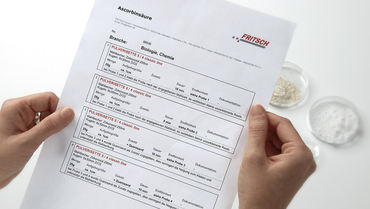Назад к обзору
NEW rotor with notched edges!
Different versions of the PULVERISETTE 19
In order to offer for each application the suitable mill, the new models were equipped with different powered motors and with variable rotational speeds. This allows the user to select an instrument exactly matching the requirements of their application. For fine comminution you select the fast Universal Cutting Mill PULVERISETTE 19 with variable rotational speeds of 300-3000 rpm. For the powerful comminution we recommend the slower PULVERISETTE 19 with variable rotational speed of 50-700 rpm.
Fast or slow running - which is the right one?
The sample characteristic plays the main role in the selection of the rotational speed. [1]
• Fracture behaviour: brittle, fibrous, ductile or visco-elastic
• Thermosensitivity
• Feed size and final fineness
• Component leakage like for example essential oils or moisture
The advantages of a continuous system
Basically, in the comminution technology there is a distinction made between batchwise (for example. Planetary Ball Mills) and continuous comminution (for example Cutting Mill with Cyclone). [2]
A big advantage of the continuous comminution is the so called „In Process“ Control.
Therefore sensitive parameters like the temperature or fine dust development can be monitored and regulated better. If for example, the output on the Cyclone is clearly reduced this may be an indication that there might be adhesions on the sieve cassette. These adhesions are favoured due to high temperatures during this process.
The new rotor with notched edges never completely closes the grinding chamber completely thus allowing optimal air flow. This significantly increases the throughput and makes the use of very fine sieves for larger quantities possible in the first place. This effect is particularly decisive especially for samples with residual moisture (food stuffs, feed or plants) and samples with a low melting point (plastics).
Direct comparison of temperature and particle size


Comminuted were 100 g hops at 3000 rpm, with the new rotor with the notched edges made of hardened stainless steel, sieve cassette 0.5 mm trapezoidal perforation and high performance cyclone separator.
Larger throughput and less cleaning effort

In the future it is also possible to process difficult samples like for example greasy rabbit feed pellets in significantly larger batches. The test series conducted in the FRITSCH laboratory with various samples show overall a very positive result.
If you are interested we will conduct an individual Sample Grinding for you!
-
Download the FRITSCH-report as PDF file
-
Detailed grinding reports
-
Sources and continuative literature
[1] H.G. Hirschberg: Handbuch Verfahrenstechnik und Anlagenbau: Chemie, Technik und Wirtschaftlichkeit, 1.Auflage 2014
[2] K. Schwister, V. Leven: Verfahrenstechnik für Ingenieure: Ein Lehr- und Übungsbuch, 2.Auflage, 2014
Назад к обзору







